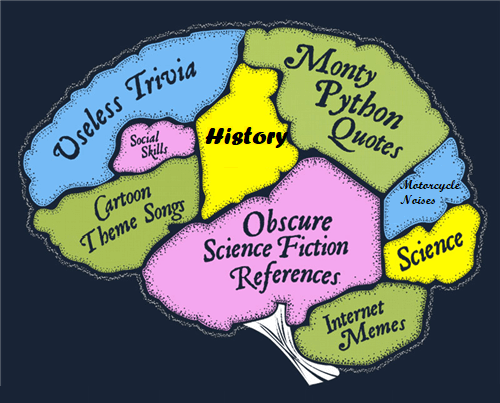Big History, according to Khan Academy, is "a unified account of the entire history of the Universe that uses evidence and ideas from many disciplines to create a broad context for understanding humanity; a modern scientific origin story." It covers history from the Big Bang through to the present in an interdisciplinary way, using the summary findings from biology, cosmology, astronomy, geology, paleontology, and anthropology to show what happened before homo sapiens became the dominant species on the Earth. It is NOT an account of the past in teleological terms, with humanity as the the raison d'être for evolution, the Universe, and existence itself. Rather it maintains that viewed purely scientifically, humanity's significant yet absolutely miniscule context is a teeny-tiny speck compared to the incomprehensible time span of the Universe.
One of my all-time favorite animals from the paleontological past (edged out only slightly by the dinosaurs), are trilobites. If I ever teach a class in Big History, trilobites will get an entire lesson, at least.
Trilobites are an extinct marine arthropod, whose name comes from the Greek tri- "three" + lobos "lobe" -- so called because their body is divided into three lobes:
They crawled along the bottom of the sea, but also swam through the water and when under attack they could scrunch themselves up into a tiny ball, protecting their vulnerable underside with their hard carapace (see animation above). They were one of the earliest animals to evolve sight, and their vision was more than a simple detection of light and dark. They appear to be the first creatures to evolve an apposition compound eye -- each lens acts independently to create a mosaic image of what a creature sees, like modern insects. Or rather, modern insects see just like trilobites, During their long existence they evolved into over 20,000 species ranging from under 1 centimeter long to over 1 foot in size (see Trilobites: Variations on a Theme, New York Times, March, 3, 2014),
The last trilobites disappeared in a mass extinction about 252 million years ago.
 |
| Excerpted from The Cartoon History of the Universe https://www.zipcomic.com/the-cartoon-history-of-the-universe-issue-1 |
During that time trilobites survived a number of minor extinction events and two major mass extinctions (see chart below) that had eliminated almost all the other lifeforms that existed when they first appeared. The first one, the Ordovician Mass Extinction, was 450–440 million years ago at the Ordovician–Silurian transition when 85 percent of all species died out. The Second was the late Devonian Mass Extinction, 375–360 million years ago near the Devonian–Carboniferous transition, when 70 to 80 percent of all animal species went extinct.
The one that finally got them, the so-called "Great Dying" was the mass extinction from the transition of the Permian to the Triassic, killing off 90 to 96 percent of all species and bringing the Paleozoic Era, and the mighty trilobite, to a final end.
.png) |
| Attribution: Dragons flight (licensed under the Creative Commons Attribution-Share Alike 3.0 Unported license) |
The video below ("Six Extinctions In Six Minutes - Shelf Life #12" by the Museum of Natural History) examines six mass extinction stories. The trilobite segment is from about 1 minute to 2:16.
Over the quarter of a billion years of trilobites in the fossil record, it becomes apparent that many trilobites appeared very similar to each other, but other species evolved many variations (see article above, "Trilobites: Variations on a Theme"). Today, both gradualism -- an evolutionary model that refers to the tiny variations in an organism or in society that happen over time to make a better fit for animals (or humans) in their environment -- stasis with punctuated equilibrium are considered essential processes to the evolution of life on earth. But that was not always the case.
"In the late 1960s, Niles Eldredge was a graduate student with a passion for trilobite eyes. He had been taught to expect slow and steady change between the specimens of these Devonian arthropods he collected for his dissertation.Only his trilobites were doing one of two things: staying the same, or evolving in leaps.Several years later, Eldredge, along with co-author Stephen Jay Gould, turned his observations into a theory known as “punctuated equilibria”: the idea that species stay relatively the same, or at equilibrium, throughout the fossil record save for rare bursts of evolutionary change.
Below is another video from the Museum of Natural History, "Niles Eldredge: Trilobites and Punctuated Equilibria." Enjoy!
 |
| http://www.sheldoncomics.com/archive/210205.html |
Some trilobites are SUPER CUTE though
 |
| Trilobite plush organism https://myscienceshop.com/product/82105 |







No comments:
Post a Comment